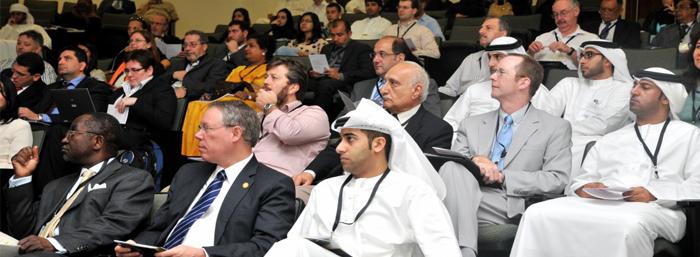- About
- Admissions
- Study at AUS
- Prospective Students
- Bachelor's Degrees
- Master's Degrees
- Doctoral Degrees
- Admission Publications
- International Students
- Contact Admissions
- Grants and Scholarships
- Sponsorship Liaison Services
- Testing Center
- New Undergraduate Student Guide
- New Graduate Student Guide
- File Completion
- New Student Orientation
- Payment Guide
- Executive Education
- Students with Disabilities
- Academics
- Life at AUS
- Research
- Contact Us
- Apply Now
- .

International experts discuss use of x-ray techniques in art and cultural heritage at AUS
Leading academics and prominent industry leaders from around the world convened at American University of Sharjah (AUS) today, December 7, at an exciting conference held to discuss the use of x-ray techniques in advancing knowledge of art and cultural heritage. Held under the patronage of His Highness Sheikh Dr. Sultan Bin Mohammad Al Qassimi, Supreme Council Member, Ruler of Sharjah and Founder and President of AUS, the International Conference on the Use of X-Ray (and related) Techniques in Arts and Cultural Heritage (XTACH11) was sponsored by Sharjah Museums Departments, Tashkeel and the International Atomic Energy Agency (IAEA).
Distinguished guests at the conference included Ambassador Hamad Al-Kaabi, Permanent Representative of the UAE to the International Atomic Energy Agency and Kwaku Aning, Deputy Director General of the IAEA; Manal Ataya, Director General of Sharjah Museums Department(SMD) ; Hamid Al Nuaimi, Vice Chancellor of the University of Sharjah and senior officials of AUS and UoS.
XTACH11 provides a forum for scientists in the region to interact, exchange ideas and possibly start collaborations with each other and with the international community. The conference covers a variety of topics including the usage of x-ray and micro beam x-ray analysis, synchrotron-based techniques, ion beam and neutron-based techniques, optical imaging and mass spectroscopy and chromatography techniques used in the diagnosis and conservation of cultural heritage materials and the environmental impact on cultural heritage. It also brings together leading experts, academics, researchers, scientists, artists and students from the world's premiere institutions to discuss the latest developments in the field from both scientific and cultural aspects.
In his opening remarks, Dr. Peter Heath, AUS Chancellor, said "This conference is the culmination of a three-year project by members of the physics faculties of both AUS and the neighboring University of Sharjah; a project that saw the setting up of the UAE's first-ever national research laboratory to promote the use of scientific techniques in cultural and environmental applications.
"I must express my appreciation for their dedication in bringing this project to fruition and for their hard work in organizing this conference. I am confident that it will further the understanding of these techniques, for the study and conservation of artifacts, that are an integral part of the region's cultural heritage," added Dr. Heath.
In her remarks, Manal Ataya, said: "I would really like to thank AUS for organizing this conference which we are delighted to support. We are very keen to develop archeology-related aspects and ways of preservation in line with our commitment to the vision of His Highness Sheikh Dr. Sultan bin Mohammed Al Qassimi, Supreme Council Member and Ruler of Sharjah, which aims to drive the emirate's successful efforts to preserve heritage, safeguard our national treasures and most importantly lay the foundation for the nation to learn and be proud of our rich history and our contribution to world civilizations.
Distinguished speakers at XTACH11 include Rene van Grieken and K. Janssens, University of Antwerp, Belgium; Thomas Calligaro, Centre de Recherche et de Restauration des Musées de France; and Stefano Ridolfi, Ars Mensurae, Rome, Italy.
XTACH11 also includes a unique archaeological exhibition at which some archaeological artifacts are being displayed for the first time. These include pottery jars from 3200 BC to 1000 AD; bronze arrowheads, 800 BC; alabaster vessels, 100 BC; coins, 100 AD; and iron swords, 100 AD.
"The conference provides an opportunity for people working in cultural heritage, to interact with scientists to apply advanced scientific techniques such as nuclear and x-ray methods in solving different issues in the field," said Dr. Nasser Hamdan, Professor of Physics at AUS. "It also provides a platform where national and regional decision makers can meet with experts and discuss the impact of science on cultural heritage," he added.
Organized in collaboration with Sharjah Department of Culture and Information (Directorate on Antiquities), Sharjah Archaeology Museum, the conference proceedings will be published in the peer reviewed IOP Conference Series: Materials Science and Engineering (MSE).
The conference will end tomorrow, December 8, 2011.

